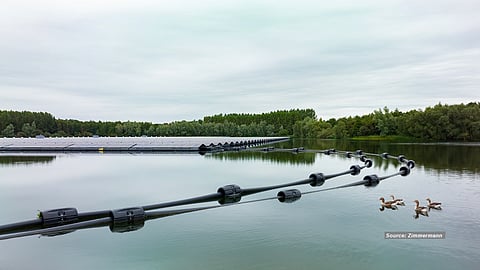

The ZIM Float System, with pontoons and a steel mounting structure, forms solar islands typically covering 12,500 m² and generating about 2.3 MW
Made with HDPE with UV protection and anti-corrosion coating, the system accommodates 12, 16, or 18 modules of any type
Zimmermann offers a 6-year warranty for the floating structure, anchoring, and mooring, with optional extensions
Zimmermann PV-Steel Group specializes in mounting structures for PV panels, particularly for utility-scale projects. Their latest line extension, Zimmermann PV-Floating, offers mounting solutions specifically designed for large-scale solar installations on water bodies. Zimmermann’s ZIM Float System is designed for freshwater installations. It consists of pontoons with a steel mounting structure, integrated inverter and transformer boats, maintenance ways, cable ducts and wave barriers. A ‘ZIM Float’ system is supported on ‘solar boats’ which are connected to each other to form islands of various sizes. A typical floating powerplant from Zimmermann covers a water area of 12,500 m2 with approximately 2.3 MW capacity. The system is built with HDPE with UV protection and anti-corrosion coated and environment-friendly steel. Each boat can accommodate 12, 16 or 18 modules of any type; however, the company recommends glass-glass framed modules.
ZIM Float consists of a flexible steel substructure that can be adjusted to accommodate solar modules of nearly any size(M6, M10, M12). The modules are typically arranged at an inclination between 10° and 15° in an East-West orientation, and at 5° in the south orientation. The design allows for very good air circulation, promoting higher cooling effect, which increases the energy yield by 4% to 6%, according to Zimmermann. The floating system from Zimmermann has a water coverage of about 20% and can hold for average wind speeds of 160 km/h and 220 km/h wind gusts. The standard configuration comes with a snow load bearing capacity of 0.48 kN/m2 to 1 kN/m2 and a wave height of 0.8 m, while the system is also offered optimally with higher snow loads of up to 1.5 kN/m2 and higher wave heights with special wave barriers. Zimmermann’s FPV solution works with bottom anchoring as well as shore anchoring using galvanized steel.
Zimmermann can produce individual ramming anchors for bottom or shore anchoring. These can be installed by a special anchor boat with integrated GPS guidance; anchors can be accurately positioned and installed in water up to 70 m deep. The mooring system design, which according to the company is site-specific, typically supports a 20 m variation in the water level, while the company also meets higher variations by adapting the mooring design. Zimmermann offers a 6-year warranty for floating structure anchoring and mooring with an optional extension for the floating structure.
The text is an excerpt from the TaiyangNews Floating PV 2024 Report, which can be downloaded for free here.
